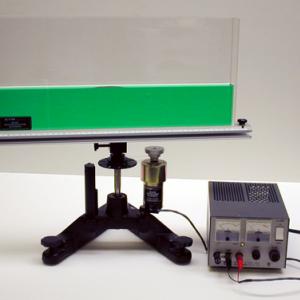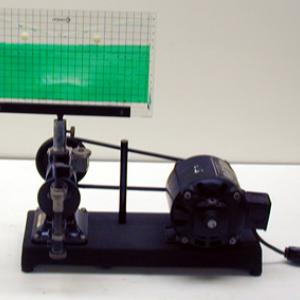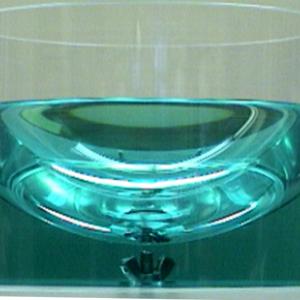College of Liberal Arts & Sciences
1D52.20 - Water Parabola
The Pasco rotator with the 1" wide accelerometer can be controlled very nicely to the desired rotation rate.
Attach the accelerometer to either the rotating air table or the mechanical rotator. The liquid will form a parabola as it is rotated. Attach the accelerometer to a rolling car. As you accelerate the car the liquid will gather in a wave at the back of the accelerometer, its height being a function of the acceleration.
- Erlend H. Graf, "Apparatus for the Study of Uniform Circular Motion in a Liquid", TPT, Vol. 35, #7, Oct. 1997, p. 427.
- J. Harris and A. Ahlgren, "Some Simple Experiments and Demonstrations", TPT, Vol. 4, #7, Oct. 1966, p. 314.
- Mm - 8: Freier and Anderson, A Demonstration Handbook for Physics.
- "D25: Uniform Circular Motion", Concepts in Motion, The Project Physics Course - Teachers Resource Book, p. 67.
- Robert Ehrlich, "F.1, Spinning a Water-Filled Cylinder", Turning the World Inside Out, p. 66- 67.
- Robert, Ehrlich, "Why Toast Lands Jelly Side Down", Zen and the Art of Physics Demonstrations, p. 50-52, 57-58.
- "Water Spinner", Exploratorium Science Snackbook.
Disclaimer: These demonstrations are provided only for illustrative use by persons affiliated with The University of Iowa and only under the direction of a trained instructor or physicist. The University of Iowa is not responsible for demonstrations performed by those using their own equipment or who choose to use this reference material for their own purpose. The demonstrations included here are within the public domain and can be found in materials contained in libraries, bookstores, and through electronic sources. Performing all or any portion of any of these demonstrations, with or without revisions not depicted here entails inherent risks. These risks include, without limitation, bodily injury (and possibly death), including risks to health that may be temporary or permanent and that may exacerbate a pre-existing medical condition; and property loss or damage. Anyone performing any part of these demonstrations, even with revisions, knowingly and voluntarily assumes all risks associated with them.





